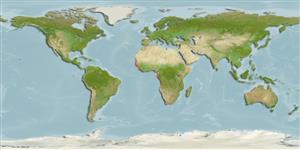>
Gobiiformes (Gobies) >
Gobiidae (Gobies) > Gobiinae
Etymology: Nematogobius: Greek, nemas, -atos = filament + Latin, gobius = gudgeon (Ref. 45335).
More on author: Sauvage.
Environment: milieu / climate zone / depth range / distribution range
生態学
海; 新鮮な水; 汽水性の 底生の; 両側回遊性 (Ref. 46888). Tropical; 20°C - 25°C (Ref. 12468)
Eastern Atlantic: Senegal to Angola (Ref. 57403), including the Gulf of Guinea and offshore islands (Ref. 4343, 79590). Also reported from the Cunene in Namibia (Ref. 33857) and Angola (Ref. 120641).
サイズ / 重さ / 年齢
Maturity: Lm ? range ? - ? cm
Max length : 8.0 cm TL オス/雌雄の選別がない; (Ref. 57403)
背面の脊椎 (合計): 7; 背鰭 (合計): 112; 肛門の骨 1; 臀鰭: 9 - 10. Diagnosis: mental barbels long, nasal barbels shorter; 4-5 rows of teeth in upper jaw, teeth in outer row larger than teeth in inner rows, which are curved posteriorly; 4 rows of slightly recurved teeth in lower jaw, outer row with largest teeth, except for mid-lateral teeth of inner row, which are similar in size to teeth in outer row; operculum, suboperculum and suborbital region scaleless; nape with some (maximum 14) small cycloid predorsal scales in a narrow band, not extending anteriorly beyond level of preoperculum; scales on abdomen smaller than those on flanks; 30-34 (usually 33 or 34) ctenoid scales in a longitudinal series (including 2 scales on caudal fin base), and 10-12 (usually 11) in rearward transverse series; 1st dorsal fin: VI; 2nd dorsal fin: I,11-12; anal fin: I,9-10; pectoral fins: 18-19 (rarely 17); caudal fin with 16-17 segmented rays, 14-15 of which are branched (Ref. 57403, 79590).
Coloration: Preserved specimens: light brown, with dark spots on flanks forming up to 10 irregular, dark cross bars, darkest at lateral midline; dorsal-fin rays with 3-4 spots, forming irregular longitudinal bands on fins; pectorals with a dark spot at upper part of base, distinct in life but fading after lengthy or poor preservation; caudal fin with spots forming vertical bands (Ref. 57403, 79590). In life: bands and spots on fins more distinct; body yellowish ventrally, yellowish brown dorsally; suborbital region with alternating yellow and dark patches (Ref. 57403, 79590).
Common in brackish waters of estuaries, but may migrate up rivers into freshwaters, often at considerable distance from the sea (Ref. 57403, 79590). Maximum reported standard length 65.1 mm (=78 mm TL)(Ref. 79590).
Life cycle and mating behavior
成熟 | 繁殖 | 放精 | 卵 | 生産力 | 幼生
Harrison, I.J., P.J. Miller and F. Pezold, 2003. Gobiidae. p. 625-666 In C. Lévêque, D. Paugy and G.G. Teugels (eds.) Faune des poissons d'eaux douce et saumâtres de l'Afrique de l'Ouest, Tome 2. Coll. Faune et Flore tropicales 40. Musée Royal de l'Afrique Centrale, Tervuren, Belgique, Museum National d'Histoire Naturalle, Paris, France and Institut de Recherche pour le Développement, Paris, France. 815 p. (Ref. 57403)
Human uses
水産業: 興味がない
より多くの情報
共通名の類義語代謝捕食動物生態毒性繁殖成熟放精卵の集合体生産力卵卵の開発
Age/Size成長体長-重さLength-length体長組成形態計測学形態学幼生幼生の動力補充豊度BRUVS
参考文献水産養殖水産養殖の紹介緊張遺伝子のElectrophoreses遺伝病気行列NutrientsMass conversion
協力者画像Stamps, Coins Misc.音シガテラ(食中毒の名前)速度泳ぐ 型式カマOtoliths脳視覚
用具
特記事項
XMLをダウンロードして下さい
インターネットの情報源
Estimates based on models
Preferred temperature (Ref.
123201): 19 - 27.9, mean 25.6 °C (based on 330 cells).
Phylogenetic diversity index (Ref.
82804): PD
50 = 0.7500 [Uniqueness, from 0.5 = low to 2.0 = high].
Bayesian length-weight: a=0.00708 (0.00333 - 0.01504), b=3.09 (2.92 - 3.26), in cm total length, based on LWR estimates for this (Sub)family-body shape (Ref.
93245).
栄養段階 (Ref.
69278): 3.3 ±0.3 se; based on size and trophs of closest relatives
回復力 (Ref.
120179): 高い, 15か月以下の倍増期間の最小個体群 (Preliminary K or Fecundity.).
Fishing Vulnerability (Ref.
59153): Low vulnerability (10 of 100).
Nutrients (Ref.
124155): Calcium = 441 [232, 1,021] mg/100g; Iron = 1.54 [0.85, 2.96] mg/100g; Protein = 17.4 [15.5, 18.9] %; Omega3 = 0.177 [0.070, 0.377] g/100g; Selenium = 40.4 [19.0, 109.2] μg/100g; VitaminA = 32.3 [10.5, 88.5] μg/100g; Zinc = 2.57 [1.74, 3.76] mg/100g (wet weight);
